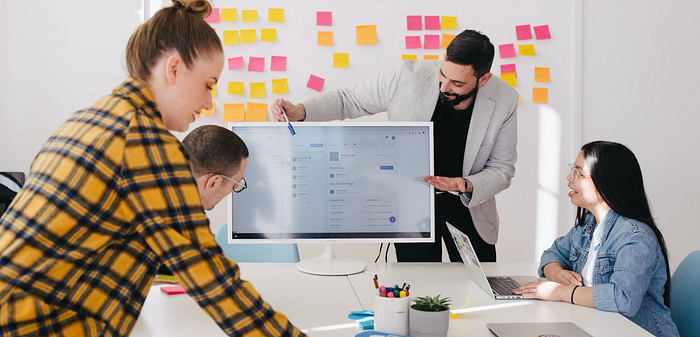Personalize, Optimize, Innovate: The Future of Retail Tech
 Sophelle
SophelleThe retail world is moving fast — faster than most of us can keep up. With online shopping booming, customer expectations are rising just as quickly. Shoppers want tailored experiences, lightning-fast service, and seamless interactions. So how do retailers rise to the challenge?
It starts with embracing ecommerce personalization services, choosing the right retail technology systems, and showing up at the right retail trade shows. In this guide, we’ll explore what it takes to stand out in today’s competitive landscape, why system selection and implementation matter, and how a Free Ecommerce personalization Trial can help you kickstart your journey.

Introduction: Retail’s Digital Shift
Retail has entered a new era. Whether it’s curbside pickup or personalized online ads, everything is changing — and fast. Today’s customer expects an experience that feels less like a transaction and more like a conversation. This evolution demands better systems, smarter data use, and strategies that prioritize individual shoppers over mass appeal.
Understanding Ecommerce Personalization
Ecommerce personalization is more than just putting a customer’s name in an email. It’s about showing the right products, at the right time, in the right way. Think of it like walking into a favorite store where the staff already knows your preferences and offers just what you need. From personalized product recommendations to dynamic landing pages, personalization boosts loyalty and increases conversions — because when people feel seen, they buy more.
Why a Free Ecommerce Personalization Trial is Worth It
Before investing in a full solution, many retailers choose to explore a Free Ecommerce personalization Trial. This trial gives you hands-on experience with personalization tools, showing you exactly how customer behavior data can be used to create tailored experiences. It’s like taking a test drive before buying a new car. You get to experiment, learn, and evaluate the platform’s impact — without any risk.

Retail Solution Implementation Explained
Implementing a new retail solution isn’t just a technical project — it’s a business transformation. From inventory systems to customer loyalty programs, everything must work together smoothly. A well-executed Retail solution implementation aligns your processes, people, and technology so your business can operate more efficiently. When done right, it reduces errors, improves performance, and unlocks new capabilities for growth.
Breaking Down Retail System Implementation
The process of Retail System Implementation typically begins with planning. This includes mapping out your current workflows and identifying inefficiencies. Then comes system configuration — customizing software to meet your specific operational needs. After that, it’s time for testing, training, and gradual rollout. Finally, ongoing support ensures your new system adapts with your business over time. It’s not a one-time fix; it’s a long-term investment.
Retail System Selection: Making Smart Choices
Choosing the right system is critical. A mismatch can lead to frustration, wasted money, and limited growth. The best approach to Retail System Selection starts by defining your business needs. Do you need better POS integration? Inventory tracking? Customer relationship management? The right system will match your current goals but also scale with your future needs. And don’t forget to evaluate vendor support — because even the best software is useless if help is hard to reach.
The Power of Retail Technology System Implementation
This is where things get technical — but stay with us. Retail Technology System Implementation refers to putting all the parts together: hardware, software, cloud services, APIs, and third-party integrations. Imagine building a house. You need a strong foundation, solid wiring, and plumbing that works. In the same way, your retail tech stack needs a clean setup so all tools communicate efficiently. It creates a smoother experience for both staff and customers.

Optimizing for Efficiency: Retail System Optimization
You’ve chosen and implemented your systems — now what? Optimization. Just like a car needs regular tune-ups, your retail systems need to be reviewed and updated regularly. Retail System Optimization focuses on improving workflows, reducing manual processes, and ensuring your systems continue to deliver value. It’s about making small adjustments that have a big impact on performance, cost savings, and employee satisfaction.
Trade Shows for Retailers: Why They Matter
Despite the rise of virtual events, trade shows for retailers are still incredibly valuable. They’re more than just a chance to see new tech — they’re an opportunity to connect, learn, and gain insights from industry leaders. Retailers can preview the latest innovations, discover trends before they go mainstream, and build relationships with technology vendors. It’s like stepping into a crystal ball and seeing where retail is headed next.
Highlights from Retail Trade Shows 2023
The retail trade shows 2023 season brought us major innovations in artificial intelligence, omnichannel solutions, and supply chain transparency. Retailers got hands-on with new platforms that offered predictive analytics, machine learning personalization, and unified commerce systems. There was also a growing focus on ESG (Environmental, Social, Governance) and how tech can support sustainable practices in retail.
Previewing Retail Trade Shows USA
Looking ahead, retail trade shows USA are expected to be bigger and more insightful. From the NRF Big Show in New York to ShopTalk in Las Vegas, these events showcase everything from cutting-edge retail software to emerging consumer behavior trends. Attendees can expect a blend of keynote speakers, expert panels, and live demos — all aimed at equipping retailers with tools for success.

Benefits of Attending a Retail Trade Show
Why attend a retail trade show? For starters, you get direct exposure to innovative products and services. You’ll hear from top experts, learn from case studies, and even test technologies before they hit the market. Trade shows are also great networking events. Whether you’re a startup owner or managing a nationwide chain, you’ll walk away with insights and connections that can shape your strategy.
Common Mistakes in Retail System Implementation
Many retailers rush into implementation without proper planning, leading to budget overruns and missed deadlines. Another common mistake is not involving end-users in the process. These are the people who’ll interact with the system daily, so their feedback is crucial. Also, some skip proper testing, assuming things will “just work.” They usually don’t. Careful strategy, communication, and patience are key to a successful rollout.
Future-Proofing Retail Through Technology
The retail of tomorrow will be data-driven, hyper-personalized, and seamless across channels. Technologies like AI, AR, and IoT are already transforming how we shop. Investing in strong system infrastructure today means you’re ready for these changes. It’s not about chasing trends — it’s about being agile enough to adapt as customer needs evolve.
Conclusion: Your Next Step in Retail Innovation
Now that you know what’s possible, it’s time to take action. Start small — maybe with a Free Ecommerce personalization Trial to understand what your data can do. Evaluate your current systems. Ask the hard questions about what’s working and what’s not. Then, map out a clear path for implementation and Retail System Optimization. And don’t forget to get out there — retail trade shows USA are calling.
The future of retail isn’t coming. It’s already here. The only question is: Are you ready?
FAQs
1. What are ecommerce personalization services?
They are tools and strategies that tailor online shopping experiences to individual users based on behavior, preferences, and data analytics.
2. Is a Free Ecommerce personalization Trial worth it?
Absolutely. It allows you to explore the platform’s value and test compatibility with your current tech stack before committing.
3. What is involved in Retail System Implementation?
It includes planning, configuration, testing, training, and launching new retail systems tailored to your operations.
4. Why attend trade shows for retailers?
They offer firsthand exposure to new technologies, networking with industry peers, and early insight into emerging retail trends.
5. How do I optimize my retail systems?
Regularly assess workflows, eliminate inefficiencies, and ensure your systems are aligned with evolving customer needs and business goals.
Subscribe to my newsletter
Read articles from Sophelle directly inside your inbox. Subscribe to the newsletter, and don't miss out.
Written by

Sophelle
Sophelle
Sophelle offers a full spectrum of consultant services to retail and DTC companies, including strategy, technology selection, implementation, and optimization. This comprehensive approach underscores our commitment to addressing all aspects of retail operations. As a trusted and innovative partner for retailers, we leverage deep industry expertise to provide thoughtfully approached services to help our clients thrive in the ever-changing retail landscape.